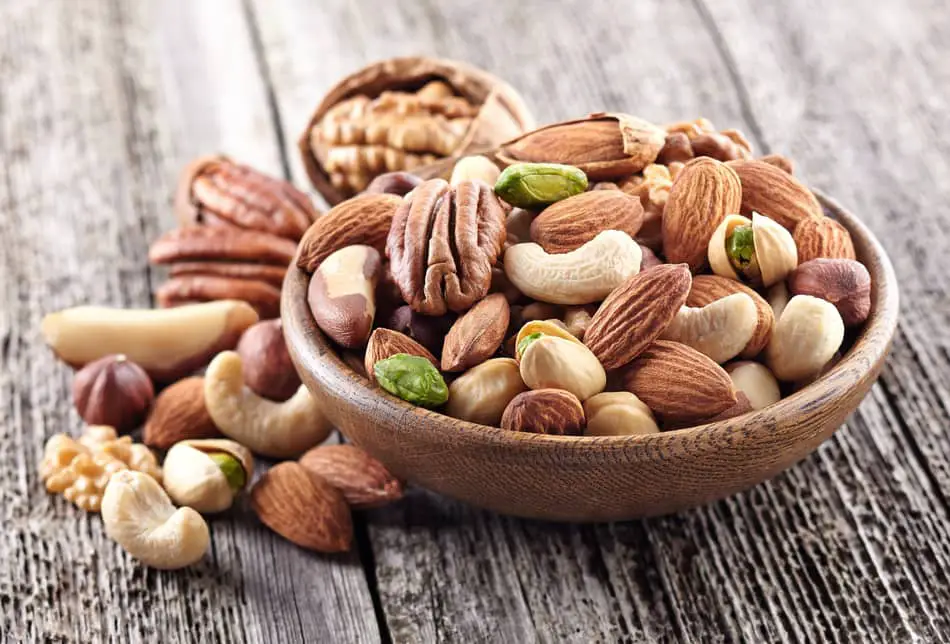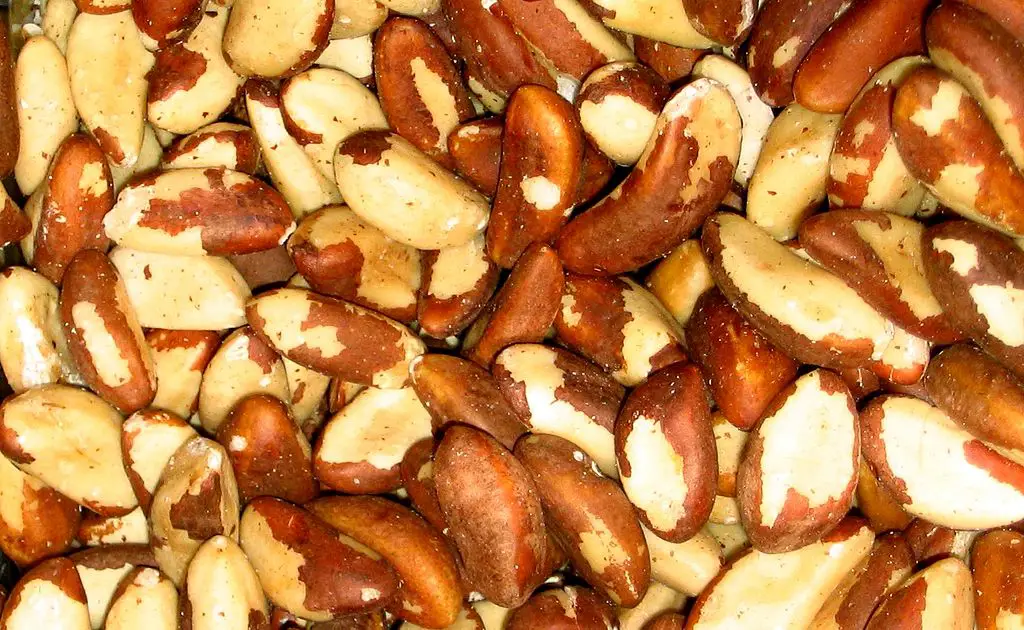
All nuts are a healthy snack or ingredient choice. They are rich in vitamins, minerals, protein, healthy fats and fiber. In addition, they have no cholesterol. But their nutritional content varies widely across types.
I analyzed the nutritional value, including antioxidant content, of ten different varieties of nuts, and have compared them side by side in the chart below.
In total, almonds are the healthiest variety of nut. Walnuts are a close second healthiest nut.
Read on for why, and learn which other nuts have strengths in specific nutrients.
1. Almonds are the Highest-Fiber Nut

All nuts are a good source of fiber. The recommended USDA for fiber is 28 grams per day1. Almonds have the highest amount of fiber of the nuts tested at 12.5 grams per 100-gram serving, so you can get close to half your daily fiber in a single serving of almonds. Pistachios are second-highest in fiber at 10.6 grams, and hazelnuts and pecans are just about tied for third place at 9.7 and 9.6 grams respectively.
Almonds are Highest in Calcium By Far
If you’d like to increase your daily intake of calcium, choose almonds when choosing nuts. At 269 grams preserving, almonds have over seven times as much calcium as cashews. Brazil nuts are in second place at 160 grams of calcium, and pistachios in third place at 105 grams.
Almonds Lead in Vitamin E
Nuts are known for being a great source of vitamin E. Almonds have significantly more vitamin E than other nut varieties at 25.6 mg per serving. Pine nuts are in a distant second place at 9.33 mg of vitamin E. Peanuts are third highest in vitamin E at 6.56 mg.
2. Walnuts Have the Best Ratio of Healthy Fats

The high fat content in nuts may make you think they are high in cholesterol and bad for your heart, but the opposite is true on both counts.
Per a study from Spain2, nuts range from 46% fat (cashews and pistachios) to 76% fat (macadamia). But their fats are predominantly the healthy kind—monounsaturated (MUFA) and polyunsaturated (PUFA). They have no cholesterol (unless fried in oil by a food company). Their saturated fat content is low (4-16%), and almost half of their total fat content consists of unsaturated fatty acids:
- Oleic acid, a MUFA, is predominant in almonds, cashews, hazelnuts, macadamia nuts, peanuts, pecans, and pistachios.
- Oleic and linoleic acid (a PUFA) are found in similar proportions in Brazil nuts and pine nuts.
- And walnuts are rich in both linoleic acid and ALA (alpha-linolenic acid).
Walnuts aren’t just the nut highest in ALA; they are the highest plant in ALA. ALA is an omega-3, an essential fatty acid associated with cardiovascular benefits. It’s the only omega-3 available from plants, so vegans benefit from a diet rich in ALA.
As the study authors state:
“The fatty acids from nuts are important contributors to the beneficial health effects of frequent nut consumption, namely protection from the development of coronary heart disease and sudden cardiac death, lowering blood cholesterol, preservation or enhancement of LDL resistance to oxidation and improvement of endothelial function.”
In summary, walnuts are the healthiest nut when it comes to their fatty acid profile. If you are eating nuts for cardiovascular health, choose walnuts.
Nuts Can Protect Against Diabetes—Especially Walnuts
Considering the high fat content of nuts, it is counterintuitive that they may protect against diabetes. But evidence shows that eating nuts increases insulin sensitivity. A 16-year study3 found that women who ate peanuts or peanut butter five times a week reduced their risk of diabetes by an astounding 74% and 79% respectively. One study4 focused on walnuts compared to other tree nuts and found that walnuts had the best effect on reducing the risk of developing diabetes.
3. Brazil Nuts Are Very High in Selenium

Brazil nuts are known for their high levels of selenium. Brazil nuts have almost 100 times as much selenium as cashews, the nut second-highest in selenium. In fact, Brazil nuts are so rich in selenium that you should only eat one or two of these nuts a day. They are an effective “selenium vitamin pill,” but this mineral can be toxic in high doses. This is the one nut on the list you should enjoy only in small quantities.
4. Pecans Have the Highest Levels of Antioxidants

Pecans have significantly higher levels of antioxidants per serving than other nuts. They have 59 times more antioxidants than almonds, and six times more antioxidants than the nuts with the next highest levels—pistachios. Walnuts are not far behind with the third-highest levels of antioxidants.
5. Peanuts are Highest in Protein

Peanuts are the highest in protein among all nuts tested (though peanuts are technically a legume, not a nut). They have almost three times as much protein as pecans, which is the nut lowest in protein (but still a very healthy nut!) Walnuts have almost as much protein per serving as peanuts, and almonds are close behind in third place.
Peanuts are relatively low in calories, making them the nut with the highest amount of protein per calorie (0.045). In my analysis of grams of protein per calorie, walnuts come in second (0.039) and almonds and pistachios are tied for third place (0.036). In other words, peanuts, walnuts and almonds give you the highest protein “bang” per calorie “buck.”
6. Cashews Are Lowest in Calories

Cashews are lowest in calories per serving of all the nuts tested, at 553 calories per 100 grams (approximately 3/4 cup). That might sound like a lot of calories, but fascinating recent research suggests that eating nuts will not make you gain weight.
Here’s a table comparing these nut varieties across a range of nutrients.
Nutrient Comparision of 10 Varieties of Nuts
| Calories | Antioxidant content (mmol/100g)* | Protein (g) | Grams of Protein per Calorie | Total Lipid (Fat)(g) | Carbohydrates (mg) | Fiber (g) | Calcium (mg) | Iron (mg) | Magnesium (mg) | Potassium (mg) | Zinc (mg) | Copper (mg) | Selenium (µg) | Thiamin (mg) | Riboflavin (mg) | Niacin (mg) | Viamin B6 (mg) | Vitamin E (mg) | Lutein + zeaxanthin (µg) | |
| Almonds | 579 | 0.18 | 21.2 | 0.036 | 49.9 | 21.6 | 12.5 | 269 | 3.71 | 270 | 733 | 3.12 | 1.03 | 4.1 | 0.025 | 1.14 | 3.62 | 0.137 | 25.6 | 1 |
| Brazil Nuts | 659 | 0.47 | 14.3 | 0.021 | 67.1 | 11.7 | 7.5 | 160 | 2.43 | 376 | 659 | 4.06 | 1.74 | 1,920 | 0.617 | 0.035 | 0.295 | 0.101 | 5.65 | 0 |
| Cashews | 553 | 0.66 | 18.2 | 0.033 | 43.8 | 30.2 | 3.3 | 37 | 6.68 | 292 | 660 | 5.78 | 2.2 | 19.9 | 0.423 | 0.058 | 1.06 | 0.417 | 0.9 | 22 |
| Hazelnuts (AKA filberts) | 628 | 0.12 | 15 | 0.029 | 60.8 | 16.7 | 9.7 | 114 | 4.7 | 163 | 680 | 2.45 | 1.72 | 2.4 | 0.643 | 0.113 | 1.8 | 0.563 | 15 | 92 |
| Macadamias | 718 | 0.77 | 7.91 | 0.011 | 75.8 | 13.8 | 8.6 | 85 | 3.69 | 130 | 368 | 1.3 | 0.756 | 3.6 | 1.2 | 0.162 | 2.47 | 0.275 | 0.54 | N/A |
| Peanuts (technically a legume, not a nut) | 563 | 0.35 | 25.2 | 0.045 | 48.8 | 16.5 | 8.5 | 89 | 2.55 | 171 | 690 | 4.43 | 1.11 | 7.1 | 0.653 | 0.131 | 12.4 | 0.346 | 6.56 | 0 |
| Pecans | 691 | 10.62 | 9.17 | 0.013 | 72 | 13.9 | 9.6 | 70 | 2.53 | 121 | 410 | 4.53 | 1.2 | 3.8 | 0.66 | 0.13 | 1.17 | 0.21 | 1.4 | 17 |
| Pine Nuts | 673 | 0.35 | 13.7 | 0.020 | 68.4 | 13.1 | 3.7 | 16 | 5.53 | 251 | 597 | 6.45 | 1.32 | 0.7 | 0.364 | 0.227 | 4.39 | 0.094 | 9.33 | 9 |
| Pistachios | 560 | 1.69 | 20.2 | 0.036 | 45.3 | 27.2 | 10.6 | 105 | 3.92 | 121 | 1,020 | 2.2 | 1.3 | 7 | 0.87 | 0.16 | 1.3 | 1.7 | 2.86 | 2,900 |
| Walnuts | 619 | 1.02 | 24.1 | 0.039 | 59.3 | 9.58 | 6.8 | 61 | 3.12 | 201 | 523 | 3.37 | 1.36 | 17 | 0.057 | 0.13 | 0.47 | 0.583 | 2.08 | 9 |
Chart Notes:
Scroll right to see more columns.
Data is for 100 grams of raw nuts without the skin (pellicle), except for pecans, which are typically eaten with the skin.
100 grams is approximately 2/3 cup of chopped nuts (varies by nut).
* For all the nuts except Brazil nuts, cashews, peanuts and pecans, the antioxidant source data includes multiple values based on different samples; for those varieties, I calculated an average number to use in this chart.
Sources:
Do Nuts Make You Gain Weight?
There is solid evidence that eating nuts does not cause weight gain5. In fact, several studies found that there is an inverse relationship between nut consumption and weight gain, meaning people who ate more nuts gained less weight than people who ate fewer nuts. This may be because the fiber and healthy fats in nuts are so filling that they reduce appetite later in the day, or that the fats in nuts may not digest completely (or both theories or other theories may be true).
You Can Eat The Skins of Nuts—And They Are Good For You
If your nuts come with the skin on, as peanuts sometimes do, feel free to eat them! The skin on nuts is called the pellicle and it can be high in antioxidants. Some people say the tannins in the skin inhibit nutrient absorption. But research shows6 shows that many nutrients from the skins are absorbed to an extent that they are capable of up-regulating antioxidant defense mechanisms and enhancing the resistance of LDL to oxidation in human plasma.
Here is the Total Antioxidant Content (TAC) of several types of nuts with and without the skin, or pellicle7.
| TAC mmol/100 g | |
| Almond with pellicle | 0.412 |
| Almond without pellicle | 0.112 |
| Peanut with pellicle | 1.967 |
| Peanut without pellicle | 0.838 |
So enjoy those skins.
Recommended Brands of Nuts
You may know this from the commercials—the Fisher brand of nuts never fries its nuts. Many people don’t realize that packages of nuts are fried. Check the ingredients. If oil (often peanut oil) is in the ingredients, then the nuts have been fried. This hurts the healthy fat profile as described above that nuts provide.
There are discussions on the internet saying that “dry roasted” nuts are actually fried in oil. I wanted to get to the bottom of this, so I contacted consumer relations at Hormel Foods, which owns the Planters brand, and asked about this. Their reply (via email):
“Our PLANTERS® Dry Roasted products are roasted without the use of oil. They are then salted or seasoned depending on the variety of peanuts.”
If you look at Planters products, only their popular peanuts have the “dry roasted” claim, and there is not added oil in their ingredients. Planters’ other products, from what I can tell, do have added oils.
So Planters peanuts are OK from an added oil perspective, but they add sugars and gelatin, among other ingredients. The gelatin means Planters peanuts are not a vegan food. If you are looking for nuts without additives, choose raw nuts, or the
